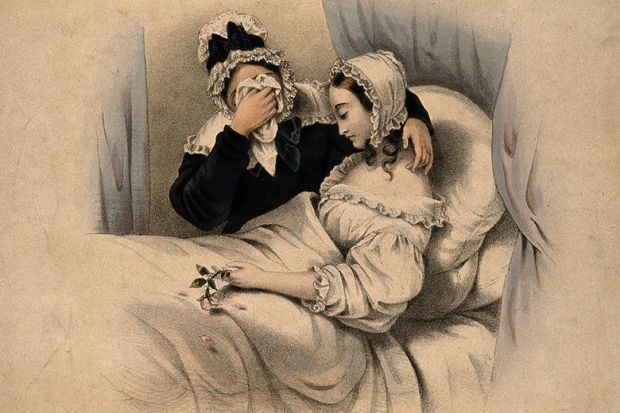It is easy to fall in love with the gentle Mary Cathcart. Thomas Gainsborough, who painted her in 1774 when she was barely 18, certainly seems to have done so. His portrait is full length and dignified, graceful and kind. An elbow propped up against an antique pillar, Mary leans lightly, her distant gaze artfully turned away from the viewer, pale except for a flush of pink visible across both cheeks. She is slight and narrow in a shimmering white satin bodice and a crimson ruched skirt, swathed in stiffened net and pearls, a ruby brooch at her breast and feathery ostrich plumes billowing from her hat.
Born to the 9th Baron Cathcart, who was ambassador to Catherine the Great, the aristocratic Mary was a society beauty and duly married a Perthshire landowner named Thomas Graham in 1774. Gainsborough’s portrait was exhibited at the Royal Academy in 1777, where the Honourable Mrs Graham was much admired. The truth, though, was more complicated and much sadder. Ravaged by tuberculosis, Mary had been too frail to sit for Gainsborough at great length and probably not in such an ornate costume. The gown, the feather and the jewels were imaginative concoctions. In retrospect, the pallor and the flush, the distant look of the eyes and the narrow form, quietly betray her illness and emaciation.
The Grahams purchased Lynedoch House near Methven, Perthshire in 1785, intending to settle there, but Mary’s illness compelled them to travel, seeking respite in the popular health resorts of the period – sea bathing in Brighton, hot springs in Clifton, and finally the warmer climes of Europe. When Mary died in France on 26 June 1792, aged just 35, Thomas was devastated. He never remarried and the portrait, apparently shrouded in muslin, was handed over to a sister and eventually bequeathed to the National Gallery in Scotland, where it remains today, one of the loveliest in its collection.
Gainsborough himself observed of the picture that it was “the completest” he had ever painted, a comment that makes sense in terms of composition, but also, perhaps, in terms of the life (and death) that it intuits of the sitter. The ruby brooch that picks up the heated stain of her cheeks, the pillar against which she supports herself, the darkened woods and sky that encircle her, all feel freighted with unspoken suggestion.
Unsurprisingly, Carolyn A. Day’s Consumptive Chic, which is concerned with what it calls the “aesthetics of consumption”, begins with Mary’s romantically sorrowful story. The book is a well-researched and diligently compiled cultural history of tuberculosis. The disease was, she notes, at its peak at the beginning of the 18th century, with high mortality rates causing around 25 per cent of all deaths in Europe, and it only declined from around 1850. Any reader of the Brontës, Jane Austen, Samuel Richardson or Charles Dickens might have some dim sense of this; the danger of “consumption” hovers constantly over heroines with susceptibly weak constitutions, a mark of their bodily infirmity and soulful sensitivity. It is to Day’s credit that she thinks to investigate this further, tracing patterns in the cultural representation of the disease in literature, art and fashion.
In the 19th century, consumption becomes more than simply a medical condition. It takes shape in a cultural imagination, an index of character and refined sensibility. “I should like to die from consumption,” Byron famously declared. John Keats, of course, did. Percy Bysshe Shelley wrote to him sympathetically in July 1820: “This consumption is a disease particularly fond of people who write such good verse as you have done…” Keats, trained in medicine and having witnessed his young brother ravaged by it in 1819, understood its fatality better than most. In Ode to a Nightingale, he remembers his brother, recording a terrible memory of “youth” that “grows pale, and spectre thin, and dies”. He is conscious too, perhaps, of his own impending fate. His friend Joseph Severn recorded his final days in Rome in graphic detail: disintegrating lungs, distended stomach and volumes of coughed blood.
The term “consumption” itself has a kind of Romantic allure. “Tuberculosis” came into widespread use in the latter half of the 19th century and is derived from the “tubercles” or nodules that developed in the lungs as a result of infection by the pathogenic bacterial species Mycobacterium tuberculosis. Certainly, it doesn’t have the ominous ring of “consumption”, whose severe weight loss seemed to “consume” the patient from the inside, leaving them gaunt and brittle, nor the awful evocativeness of the “white plague” that suggested the blanched and etiolated complexion of those infected. And these symptoms, weight loss and pallor, are crucial to the dominant presentation of tuberculosis as a “fashionable” disease. Day conscientiously gathers the evidence of a kind of cultural complicity in the casting of tuberculosis as an aspirationally “beautiful death”, specifically associated with femininity and refinement.
She notes one J. S. Campbell, rhapsodising in his 1841 Observations on Tuberculous Consumption over the propensity in tubercular patients for pallor and “transient vigour”, the “sudden flashes of the countenance from trivial causes of mental emotion, which frequently suffuse the cheek of beauty with a blush originating in a fatal tendency”. Day enumerates the specific ways that the illness could manifest itself – hectic flush, breathlessness, emaciation, glassy eyes sunk into their orbits, prominent cheekbones, whitened teeth, the visibility of veins on the surface of the skin – pointing up the cultural ideals of beauty with which it becomes so troublingly intertwined. The tubercular look, as the late historian Roy Porter has written, had become so “positively de rigueur” in the 18th century that bright young things deliberately sought to cultivate it, as if “delicacy and a tenuous grasp on life made them appealing”. Day pursues this thought, unearthing the prints and fashion plates in which thinness increasingly emerges as the signifier of a desirably delicate soul, digging up the corset designs that would place undue pressure on the respiratory organs, the beauty treatises that blithely noted how “some diseases” could “greatly improve the beauty of particular complexions”.
In Consumptive Chic, Day assembles the data, indicating the ways in which a debilitating illness came to be configured as aesthetically pleasing at a particular period of time. If she never quite tackles the question of why experiences of infirmity and emaciation should come to confer feminine beauty, it is perhaps because it is too difficult to answer. It is a question for the ages, ongoing and urgent in contemporary culture, too. Abstemiously scholarly, Day resists the temptation to stray into speculations about modern parallels, although they are apparent: the heroin chic of 1990s fashion, the pro-anorexia movements of the present day. The suffering of women remains inseparable from dominant conceptions of beauty.
Tuberculosis, Day reminds us, remains a global public health issue. The merit of this study is that it understands the ways that disease can also take form in the imagination and how bodily life is documented in culture, as well as medicine.
Shahidha Bari is senior lecturer in Romanticism, Queen Mary University of London.
Consumptive Chic: A History of Beauty, Fashion, and Disease
By Carolyn A. Day
Bloomsbury, 208pp, £70.00 and £22.99
ISBN 9781350009387 and 9370
Published 5 October 2017

The author
Carolyn Day, associate professor of history at Furman University, South Carolina, was born in Montreal but raised in Baton Rouge, Louisiana. As the daughter of academics, she says, she “grew up on a college campus and at scientific conferences, which shaped my approach to all learning. I wasn’t intimidated by what I didn’t know. I was curious not just about the work being done but also about what was missing, in what wasn’t being examined and why.”
After majoring in microbiology and history at Louisiana State University, Day went on to an MPhil at the University of Cambridge on the history and philosophy of science and medicine and then a PhD in British history at Tulane University in New Orleans. This variety of perspectives proved vital when she “stumbled across the connections between beauty and consumption and the idea that the disease was an easy and beautiful way to die…I was fascinated. Courses in microbiology had prepared me to understand the way the disease worked in the body, but not why it was rationalised in such a manner.”
It was her training in history that “allowed [Day] to understand that health and disease are more than just biological phenomena but are also produced by their social, cultural and historical contexts”.
Although Consumptive Chic does not address “contemporary beauty trends”, Day acknowledges that “discussions of the relationship between body image and health remain serious concerns, and aesthetics tend to be more powerful motivators than health concerns. We still see the glamorisation of behaviours that have serious medical consequences, like the heroin chic of the 1990s and the even more extreme pro-ana movement. The medical profession has also weighed in on the harmful effects of certain fashions or beauty trends, such as the consequences of wearing high heels, or extreme cosmetic surgery.”
Matthew Reisz
后记
Print headline: The beautiful and the damned




